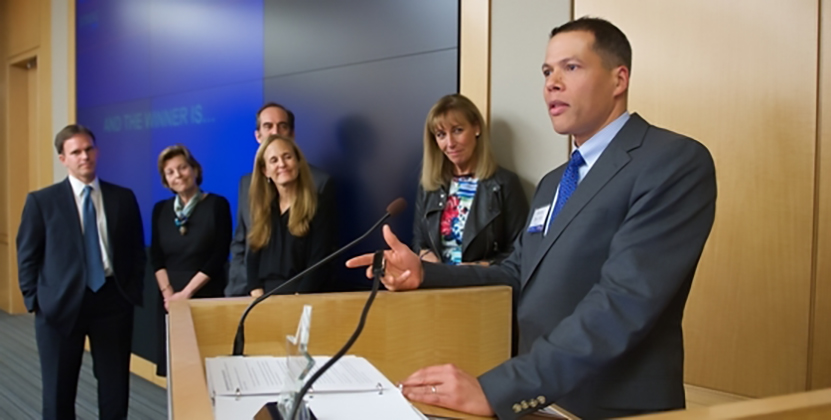
Using Silk Rods to Promote Bone Healing: A Conversation with George Dyer
Q: Can you tell us about your Stepping Strong Innovator Awards project, and what you hope to achieve?
A: Our objective in this project is to develop fully degradable surgical repair rods using silk protein and bioactive molecules to promote bone healing for large traumatic defects. We believe that orthopedic hardware with the appropriate mechanical properties—that is, fully degradable hardware that promotes new bone formation—will revolutionize orthopedic repairs by accelerating healing, reducing second surgeries, and improving long-term outcomes for patients who suffer from segmental defects.
Q: Can you tell us a little about your background and who you are collaborating with?
A: I am a practicing orthopedic surgeon with both a practical and research interest in large segmental defects of bone after trauma. My interest in this problem was deepened and sharpened by participating in the care of several survivors of the marathon bombings. I am working with David Kaplan, PhD, and Ara Nazarian, PhD. Dr. Kaplan is a senior scientist and a world expert in engineering silk, and Dr. Nazarian is a senior researcher in translational science, with extensive experience in bio-engineering and biomechanics in the field of orthopedics.
Q: How important is collaboration to the success of your project?
A: This project relies upon expertise in trauma surgery, biomedical engineering, material science, orthopedic biomechanics, and animal models. Therefore, a collaborative approach is essential for the success of this and most other projects in our field. The complementary nature of the needed skills, along with the collaborative brainstorming that led to the original idea behind this proposal, are the key strengths of our work.
“This project relies upon expertise in trauma surgery, biomedical engineering, material science, orthopedic biomchanics, and animal models … The complementary nature of the needed skills, along with the collaborative brainstorming that led to the original idea behind this proposal, are the kdy strengths of our work.”
Q: Why do patients with traumatic fractures often require second surgeries?
A: Current material options for orthopedic implants consist of nondegradable metals and degradable polymers. Metal alloys have long been the gold standard for large traumatic defect repair due to their robust mechanical properties and ease of implantation. However, the strength of the metal-based implants relative to the strength of the surrounding bone result in stress shielding—and the reduced microstrain experienced by bone, which is critical to the healing process, lead to poor bone healing, and, in some cases, the need for additional surgery. These limitations have generated interest towards degradable devices.
Screws and plates composed of degradable materials have also become lead candidates for orthopedic hardware due to reduced need for removal and improved bone healing. However, these products are still associated with inflammatory reactions due to degradation, loss of bone, and incomplete healing.
So there is still a significant clinical need to develop fully degradable orthopedic implants for large traumatic defects, which we hope will dramatically reduce the need for second surgeries.
Q: Is that why you are focusing specifically on silk-based orthopedic implants?
A: Yes. Our research shows that the limitations I describe here can be addressed with silk-based implants, which can be tuned to fully degrade over a 6–12 month time period while promoting bone healing. Gram for gram, silk is stronger than most materials. Its density is six times less than that of steel, yet it exhibits tensile properties not far from those of steel.
Q: Now that you’ve received the grant, how will you proceed?
A: Our first step is to create surgical repair rods that will restore the ability of the bone to bear weight and help with the healing process. The working hypothesis is that modification of silk protein-based rods, through layer-by-layer coating deposition, will allow us to control the release of molecules—both to help accelerate bone healing and to avoid complications. We will test our hypothesis by screening different molecules that have been shows to promote bone healing and avoid complications and find the best dose and release functions for our purposes.
Q: When do you anticipate human trials?
A: First we must assess the efficacy of the repair rods in a smaller animal model. The working hypothesis is that the silk repair rod will improve fracture fixation in a rat model with enhanced bone healing. We will test our hypothesis by medical imaging, mechanical testing, radiography, and histology. At this point, we will have generated enough pilot data to apply for a larger grant. This will allow us to validate the efficacy of the silk implants in larger animals such as sheep or goats, who are like humans in that they experience similar forces on their limbs. Upon the successful completion of these steps, we will be in an excellent position to start our first human trials.
Q: Thank you for speaking with us about your Stepping Strong research project. Any last words for our readers?
A: This whole process—from applying for the grant to the presentation on December 1—has been a terrific and exciting experience. I would like to thank the Renys and the funders, David and Betsy Epstein, for creating such a beautiful opportunity to take our research from the back burner to the next level, and for creating such a fruitful environment for collaboration. We are very grateful.
